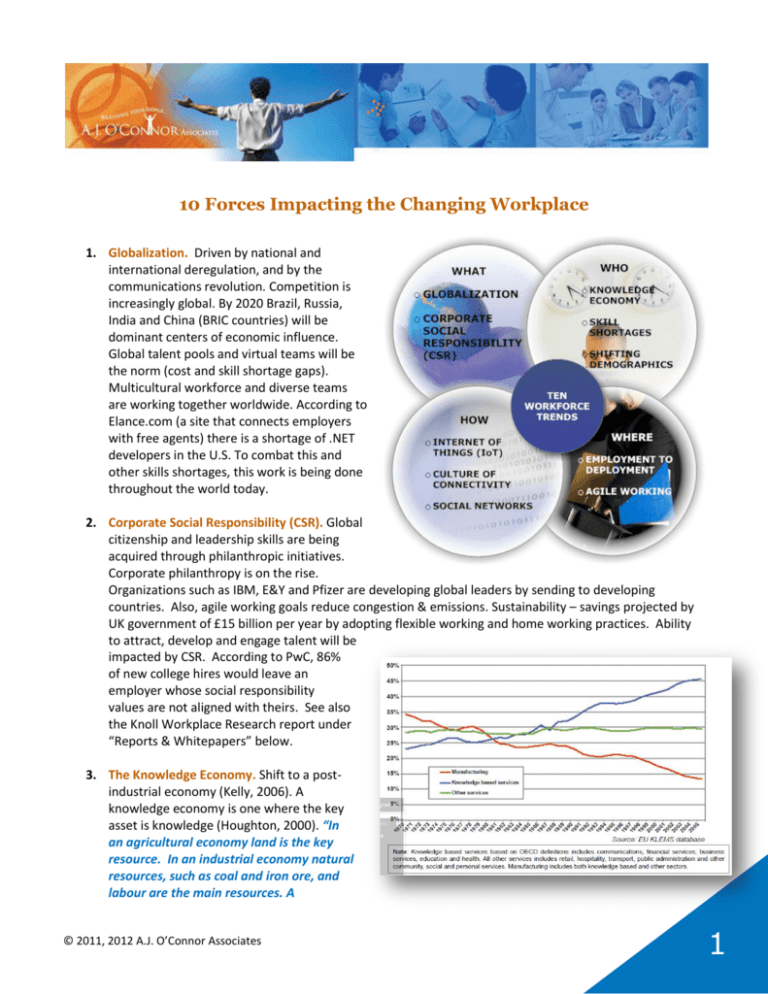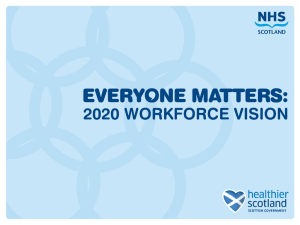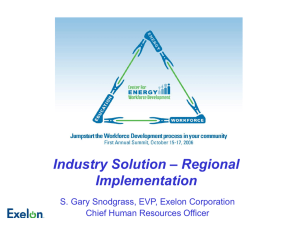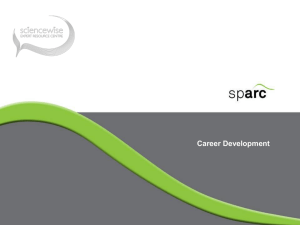Workplace of the Future: 10 Forces Impacting the Changing Workplace
advertisement

10 Forces Impacting the Changing Workplace 1. Globalization. Driven by national and international deregulation, and by the communications revolution. Competition is increasingly global. By 2020 Brazil, Russia, India and China (BRIC countries) will be dominant centers of economic influence. Global talent pools and virtual teams will be the norm (cost and skill shortage gaps). Multicultural workforce and diverse teams are working together worldwide. According to Elance.com (a site that connects employers with free agents) there is a shortage of .NET developers in the U.S. To combat this and other skills shortages, this work is being done throughout the world today. 2. Corporate Social Responsibility (CSR). Global citizenship and leadership skills are being acquired through philanthropic initiatives. Corporate philanthropy is on the rise. Organizations such as IBM, E&Y and Pfizer are developing global leaders by sending to developing countries. Also, agile working goals reduce congestion & emissions. Sustainability – savings projected by UK government of £15 billion per year by adopting flexible working and home working practices. Ability to attract, develop and engage talent will be impacted by CSR. According to PwC, 86% of new college hires would leave an employer whose social responsibility values are not aligned with theirs. See also the Knoll Workplace Research report under “Reports & Whitepapers” below. 3. The Knowledge Economy. Shift to a postindustrial economy (Kelly, 2006). A knowledge economy is one where the key asset is knowledge (Houghton, 2000). “In an agricultural economy land is the key resource. In an industrial economy natural resources, such as coal and iron ore, and labour are the main resources. A © 2011, 2012 A.J. O’Connor Associates 1 knowledge economy is one in which knowledge is the key resource. “ In the modern information and technology rich market, the trend of value has moved away from tangible goods and services to that of knowledge driven industries. Era of big data used to drive innovation and competitive advantage. Florida (1991) stated: “Capitalism is undergoing an epochal transformation from a mass production system where the principal source of value was human labour to a new era of ‘innovation-mediated production’ where the principal component of value creation, productivity and economic growth is knowledge.” 4. Skills Shortages. Shortfall of 1.5M graduates in 2020, possessing skills required for a “Knowledge Economy”. The biggest impact will be in the quality and quantity of science, technology, engineering and math (STEM) graduates required. STEM jobs are predicted to outpace more traditional jobs in both numbers and salary levels over the next decade. Between 2010 and 2020 it is estimated that the United States will lack the qualified talent to fill anywhere from 12 to 24 million essential jobs throughout our economy. These same talent shortages are beginning to appear around the world. Soon 75 percent of all U.S. jobs will demand far higher entry-level qualifications, i.e., a good liberal arts education plus postsecondary careerspecific technical skills. Today only about 25 percent of America’s workforce comfortably meets this benchmark. “… We are entering a new era of unparalleled talent scarcity, which will put a brake on economic growth around the world, and fundamentally change the way we approach workforce challenges.” “Global Talent Risk – Seven Responses,” World Economic Forum, May 2011. 5. Shifting Workforce Demographics. Demography is a key driving force in the growth of the U.S. economy, the growth of the labor force, and almost all social and economic trends. Compared with the labor force of the past decades, tomorrow’s labor force will be older, more racially and ethnically diverse, and composed of more women. The high growth rate of the U.S. civilian labor force in the last 50 years will be replaced by much lower growth rates in the next 40 years. Life expectancy will continue to rise. The World Health Organization predicts that if a male is 60 years old and healthy he can continue to work in a full time job until the age of 74 and a female can continue until the age of 77 years old. © 2011, 2012 A.J. O’Connor Associates 2 Bottom line is that the U.S. will see greater workforce diversity with more women, Hispanics and Asians, as well as an older, aging workforce, made up of five generations. 6. Employment to Deployment. Growth in newer forms of employment arrangements, with the contingent/free agent workforce projected to include 1 in every 2 workers in the next decade. Organizations will need to broaden their thinking and apply innovative approaches to attract the talent they need. One of the talent pools that organizations will need to tap more effectively is the growing pool of virtual talent labeled “contingent.” A 2009 Manpower, Inc. survey on the “Role of Contingent Workers” found that 34% of the 41,000 employers in 35 countries surveyed viewed contingent workers to be a key to the execution of their organizational strategy. “So jobs aren’t permanent, locations aren’t permanent, and workers are returning back to what I would call a free-agent type of work style. Independent contractors, part-time employees who move in and out of the workforce, temporary employees, consultants who move in and out of the workforce—that group of individuals in most of the industrialized world is already 25 to 35 percent of the workforce, on its way to becoming 50 percent of the workforce, I think, over the next decade.” Carl Camden, CEO Kelly Services 2011. Source: Manpower - International Labour Organization, 2011 Statistics, and assumed rate of 20% contingent labor based on Aberdeen calculations 7. Agile Working. Workplace environments are changing right along with employment roles. Work is becoming more about what employees do and less about where they do it. With a laptop, a Wi-Fi connection, and a mobile phone, knowledge workers can perform their jobs virtually anywhere, making the idea of going to work increasingly archaic. Adopted to reduce traffic congestion and emissions (sustainability goals); reduce organization costs (agile workspaces are 40% less expensive to operate); and for employee attraction and retention; workforce vitality. “Mobile, resident and home-based/off-site” terms to describe where we work. Growth in shared/flexible workspaces; shift from 9-5 schedules to 24/7 working, fuelled by globalization (i.e., meetings and conferences of global teams). Expect Millennials to ask about social media access, choice in technology usage at work and flexible work arrangements. According to the Cisco Connected Technology World Survey of 2,800 college graduates and young professionals, one third of respondents would accept a lower-paying job that had more flexibility with regard to device choice, social media access, and mobility than a higher-paying job with less flexibility, two thirds of respondents will ask about a company’s social media policies during the interview and 56% will refuse a job from a company that bans social media access or they will circumvent around this policy. SWARMING: Gartner has identified a nascent work style called swarming, characterized by a flurry of collective activity by anyone and everyone conceivably available and able to add value. Gartner identifies two phenomena within the collective activity; Teaming (instead of solo performances) will be valued and rewarded more and occur more frequently and a new form of teaming, which Gartner calls swarming, to distinguish it from more historical teaming models, is emerging. © 2011, 2012 A.J. O’Connor Associates 3 8. Internet of Things (IoT). We are moving into a new era in connectivity where we will see the proliferation of billions of connected devices in the world. Most of that growth is coming from machine-to-machine in the form of sensors. The number of “things” connected to the Internet has already exceeded the number of people on earth. Many of us already have 3+ devices connected to the Internet when factoring in PCs, smartphones, tablets, television devices etc. Ubiquity of mobile technology. Mobile devices will be your office, classroom & concierge and a key enabler of future work: a hyper-connected workplace. Cisco IBSG predicts the number of Internet-connected things will reach 50 billion by 2020, which equates to more than six devices for every person on Earth. Alessandro Bassi has worked with the IoT since 2004 when he joined Hitachi Europe as a researcher for advanced networking topics. When asked what excites him about it:”The Internet of Things will be a much bigger revolution than the Internet and the mobile telephony put together!” 9. A Culture of Connectivity. (2020 Workplace Chapter 5) - The “Participation Society” – borne out of social networks. “Always on” business culture. Growth in connectedness between people through the Internet is occurring at a rapid pace. The number of people with Internet access worldwide has expanded from 1.9 million in 1990 to over 2 billion in 2011. Today, 44% of Internet users are in Asia; 23% in Europe and 13% in North America (Internet World Stats Website). Mobile tools such as smartphones, tablets, netbooks, and laptop computers are now a primary source of Internet connectivity in highly developed nations, and the uptake of technology tools in less developed regions of the world has also been dominated by small, wireless devices. The latest surveys of American adults by the Pew Research Center’s Internet & American Life Project show that nearly two-thirds connect to the Web via a smartphone, tablet computer, or an on-the-go laptop computer. Eightyeight percent of American adults age 18 and older have a cell phone, 57% have a laptop, 19% own an e-book reader, and 19% have a tablet computer; about six in ten adults (63%) go online wirelessly with one of those devices. Rapid emergence of social networks like blogs, Wiki’s, LinkedIn, Facebook and Twitter. © 2011, 2012 A.J. O’Connor Associates 4 10. Social Networks. A fundamental change in the way we communicate. Used to attract talent and for continuous, just in time learning. Social networks already assisting 1 in 6 job seekers (Jobvite study Oct 2011). Unilever’s goals to attract and retain talent, especially diverse talent; to increase % of women managers to 55% in 2015 (up from 40% at start of 2011). See also the Cisco Connected World Report 2011 listed below. Half the adults and three-quarters of the teenagers in America use social networking sites (SNS) and Facebook by far is the most popular of these sites. Thirteen percent of online adults use Twitter, which represents a significant increase from the 8% of online adults who identified themselves as Twitter users in November 2010. Networked organizations are gaining a competitive edge by opening up information conduits internally and by engaging customers and suppliers strategically through web-based exchanges of information. “We found statistically significant correlations between self-reported corporate performance metrics and certain business processes that networked enterprises use…First, these organizations use social tools to scan external environments. Second, they use them to match employees to tasks: internal wikis and social networks help project leaders to identify employees with the most appropriate skills and to assign these employees to the projects for which they are best suited.” How social technologies are extending the organization. McKinsey Quarterly Implications: Leaders of the Future (Future Work – Chapter 5) (Chapter 7 of 2020 Workplace) Leadership Characteristics – (pg. 200 in 2020 Workplace & pgs. 121-124 of Future Work). “TRUST” principles based on research by The Future Work Forum at Henley Business School: Leadership development in support of globalization, Sept 2011 Culture change is crucial (Future Work – Chapter 7) – 25 cultural factors associated with future work (gender differences, country differences – Dutch “Daddy Day”). Trust is a major factor. Reading & Resources Books: Note that all authors in this section have blogs, allowing you to subscribe (via RSS) and stay connected to what is a dynamic subject area. Future Work , Alice Maitland & Peter Thomson, Nov 2011 TOP PICK! Networked – The New Social Operating System , Lee Rainie & Barry Wellman, June 2012 The 2020 Workplace – How Innovative Companies Attract, Develop and Keep Tomorrow’s Employees Today, Jeanne C. Meister & Karie Willyerd, May 2010 TOP PICK! © 2011, 2012 A.J. O’Connor Associates 5 The Perfect Labor Storm – Workforce trends that will change the way you do business, Dr. Ira S. Wolfe, August 2007 The Shift – The Future of Work is Already Here, Lynda Gratton, July 2011 TOP PICK! Five forces that will fundamentally change the way we work in the next 10-15 years: globalization, society, demography, technology and energy. You can download free chapters and a workbook from this URL. Plus, view the short video clip of Lynda, who is a professor at the London Business School. Blogs & Blog Postings 2020 Workplace Blog TOP PICK! Jeanne C. Meister & Karie Willyerd’s blog from the book of the same name. Across the Ages Blog at Harvard Business Publishing Tammy Erickson, Author and Top 50 Global Business Thinker. See also Tammy Erikson Associates’ website (where you can subscribe to her newsletter). Are You Ready to Manage Five Generations of Workers? An HBR blog posting by Jeanne C. Meister and Karie Willyerd, October 2009 Center for the Study of the Workplace : The Center for the Study of the Workplace within the School of Continuing Education is a resource at the University of Wisconsin-Milwaukee that studies the real-world impact of these workplace changes, offering shared learning from leaders in both business and academia. This website is our virtual platform for conveying thought leadership nationally and globally. Hotspots Movement - Future of Work Blog: Lynda Gratton has been named the number 12 business thinker out of 50. Her blog is also an offshoot of her book, of the same name. Tomorrow Today – Blogging about the New World of Work: This blog is a project of “TomorrowToday UK” and its associates. Dr. Graeme Codrington is co-founder of TomorrowToday, author, speaker and expert on the future world of work. His organization specializes in helping its global clients understand the realities of the new world of work and the disruptive forces shaping the future. A recent posting: The Future Workplace: How technology, globalisation and the environment is affecting the way we work. The Future of U.S. Knowledge Work in a Global Economy : TOP PICK! Tom Kucharvy’s blog focuses on helping technology companies maximize the business value they derive from their corporate social responsibility and philanthropy initiatives. Many postings deal with workforce trends, tomorrow’s jobs, future skills and STEM careers. The Perfect Labor Storm Blog: Workforce trends that will change the way you do business. TOP PICK! Dr. Ira S. Wolfe, author of ”The Perfect Labor Storm: Why Worker Shortages Won’t Go Away”. This blog was awarded the “The HCI 50 Best Blogs – Talent, 2011”. The Work Foundation Blog: The Work Foundation is a leading provider of research-based analysis, knowledge exchange and policy advice in the UK and beyond. Your Workplace in 2020 - Gartner’s Predictions: Access the full report here. © 2011, 2012 A.J. O’Connor Associates 6 Reports and Whitepapers: 10 technologies that will change the world in the next 10 years: (Internet of Things is #1!) NetworkWorld, July 2011. 3D printers, sensor networks, virtual humans and other technologies under development now will drastically change our world in the decade to come, according to Cisco chief futurist Dave Evans. An economy that works: Job creation & America's future: McKinsey Global Institute, June 2011 Are You Ready for the Era of Big Data? McKinsey Global Institute, Oct 2011 Digital Differences: Pew Internet & American Life Project, April 2012 Future Skills: A plan for growth in the knowledge economy : Charles Levy, Andrew Sissons and Charlotte Holloway. The Work Foundation. Discusses the Knowledge Economy in the U.K. and the importance of STEM skills in driving creativity and innovation. See also Innovation, Creativity and Entrepreneurship in 2020. The Work Foundation is an independent U.K. think tank on work and its future. For all reports. Future Work - Trends and Challenges for Work in the 21st Century: 1999, U.S. Dept of Labor Future Work Skills 2020: Apollo Research Institute (formerly University of Phoenix Research Institute) 2011. This report analyzes key drivers that will reshape the landscape of work and identifies key work skills needed in the next 10 years. Future Work and Work Trends. Knoll Workplace Research, April 2009 TOP PICK! http://www.aminteriors.com/wp-content/uploads/2011/03/WP_future_work_work_trends.pdf How social technologies are extending the organization. McKinsey Quarterly, Nov 2011 TOP PICK! https://www.mckinseyquarterly.com/PDFDownload.aspx?ar=2888 Labor force projections to 2020: a more slowly growing workforce. Bureau of Labor Statistics, Jan 2012 Managing the Virtual Workforce Infographic. Based on a survey of Fortune 500 companies – interesting facts and figures on today’s telecommuters, who make up 20% of the workforce. Sept 2011 Strategic Human Resources and Talent Management: Predictions for 2012: Bersin Report, November 2011 Complimentary (complimentary access to this report upon free member registration). Although it addresses the short-term, some of the longer term trends are highlighted. (E.g. skill shortages, social learning and talent acquisition, social rewards, global hiring, etc.) The 21st Century at Work: Forces Shaping the Future Workforce and Workplace in the United States: Rand Corporation, 2004. Focuses on three major factors that are expected to shape the world of work in the coming decades: shifting demographic patterns, the pace of technological change, and the path of economic globalization. The Cisco Connected World Report 2011, September 2011 TOP PICK! An important window into the attitudes of college graduates and young professionals from around the world towards technology and remote working. Chapter 1 and Chapter 2. © 2011, 2012 A.J. O’Connor Associates 7 The Cisco Connected World Report Employee Expectations, Demands, and Behavior –Accessing Networks, Applications, and Information Anywhere, Anytime, and with Any Device: October 2010 The Future Workspace: The Mosaic Consortium, 2006. MOSAIC stands for “Mobile Worker Support Environments”. This report looks at the current state of the art and current practice, future scenarios of mobile workspaces, and challenges for research and innovation resulting in a roadmap and research agenda for the future. The Future of Apps and the Web: Pew Internet & American Life Project, March 2012 The Future of Jobs and Careers: Edward E Gordon. Techniques, Sept 2009 The State of Telework in the U.S. - How Individuals, Business, and Government Benefit: Telework Research Network, 2011 The U.S. Employment Challenge: McKinsey Quarterly, August 2011. You will need to register to download this report, but registration is free. The CEO of Kelly Services and a Nobel laureate economist, Michael Spence discuss the changing face of US employment and the obstacles to job creation. The Workplace 2020: Predictions from Gartner, August 2010 Transitioning to Workforce 2020: Cisco Whitepaper, 2011. TOP PICK! This whitepaper explores disruptive trends (globalization, demographics and technology), transformations in work and workers and what this means for organizations and leadership. Videos: Cisco Technology Connected World Report 2011 (2 videos here) How will be the world in 2020? TOP PICK! The vision of Telefónica I+D that highlights demographic and technological some points of view. May 2011 The Future of Work: Educational video about major trends in the future of work. Dec 2009 The Perfect Labor Storm: 2007. Where Have All The Workers Gone is a 5-minute presentation from workforce trends expert and Perfect Labor Storm 2.0 author Ira S. Wolfe about demographic changes, worker skills, aging workforces and more are changing the way every organization will do business. The Internet of Things: 2010. Video featuring, from IBM: Mike Wing, Andy Stanford-Clark and John Tolva. The planet has grown a “nervous system” with more things than people on the Internet. Think – A Forum on the Future of Leadership: TOP PICK! Video from IBM’s Sept 2011 Forum of global leaders. See also the Forum Website. © 2011, 2012 A.J. O’Connor Associates 8









